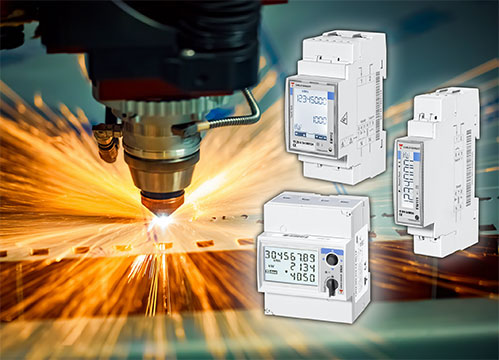
Posted to News on 29th Apr 2022, 11:29
Getting a clear picture of energy usage

Monitoring each stage of a manufacturing process can ensure it is run in the most energy efficient way. It might also make it possible to take action to minimise grid electricity consumption at times of peak tariff says Will Darby, managing director of Carlo Gavazzi.
Reducing electricity use is good for business and for the environment. But for many manufacturers electricity use is not optimised because managers do not have sufficient information to make informed decisions.
The old adage that you cannot manage what you don’t measure is certainly true when it comes to electricity consumption. The simple function of installing metering on all of the primary energy-consuming plant in a factory or manufacturing facility will provide managers with a huge amount of useful data; data that can be used to optimise the way a plant is run.
Meters such as Carlo Gavazzi’s EM24 3-phase energy analyser are well suited to both active and reactive energy metering of individual items of machinery with a high power consumption, while for single phase equipment Carlo Gavazzi’s EM111 and EM112 1-phase energy analysers are ideal.
Installation of the EM24 energy analysers proved particularly useful at one automotive parts manufacturing plant, where the operator wanted to be able to see how much energy each CNC machine was consuming for each specific machining processes, such as milling and drilling, in order to assign an energy cost to each component. The EM24 units enabled minute-by-minute energy data to be captured for each CNC machine.
To record and transmit the data the energy analyser units were connected to Carlo Gavazzi’s UWP Energy Management module. This is a micro-PC which is pre-installed with a web server. This smart energy monitoring solution makes it a simple task to determine energy usage of both individual items of equipment and the production facility’s overall energy usage both as real time consumption and as historical data either in the facility or viewed remotely. The data will allow operators to see how much power is being used, where it is being used and when.
To form a complete picture of energy usage patterns, in addition to the manufacturing plant the energy used by HVAC equipment, lighting circuits, computer servers and other power-consuming auxiliary equipment should also be metered.
The summation of energy used in production with energy used by ancillary plant will enable a business to determine how much of its existing electricity supply is being used and when. Accurate energy consumption data will enable a business to understand how much electricity capacity is available for a business to confidently invest in new machinery or to expand production. Alternatively, if the supply is far bigger than is needed there might be an opportunity to press for a reduction in the electricity supply tariff to save on costs.
For larger manufacturing facilities, particularly those with multiple production lines, a centralised energy monitoring solution will allow all of the collected data to be pooled and analysed to help paint a bigger picture of energy use patterns. Such information might be useful in helping enable a business to control electricity grid network charges, particularly if it means minimising or eliminating the use of grid power during Triad charge periods.
Dealing with peaks in electricity demand – particularly during the winter months – is one of the key challenges faced by the National Grid. Triad charges were introduced to make energy really expensive at times when the electricity grid is under stress. The intention being that large users of energy will stop using as much energy and demand will drop, which helps avoid the cost of reinforcing the grid.
Under the Triad system consumers pay a charge based on their location and their electricity use over three 30-minute Triad periods. Triad periods occur when the transmission network is operating at its highest loads between the months of November to February.
Once a manufacturer has visibility of consumption, it can start to adapt its processes to optimise energy. There are many ways to minimise consumption: simply turning off lights when not in use, suspending early evening production or even re-scheduling production times, can dramatically help with the reduction of energy use during anticipated Triad periods.
Visibility of electricity consumption afforded by a comprehensive metering and control strategy will also allow a business to decide whether it is feasible to maintain, or shift the core production processes during grid peaks or to consider off-grid options, such as battery back-up now that advances in battery technology and other energy storage techniques are making building level electricity storage achievable.
Of course, energy consuming systems evolve over time as equipment is added or replaced or building usage or manufacturing processes change. Monitoring and metering should not be seen as a ‘nice to have’ but as a fundamental tool in enabling a facility to be running efficiently. By continuously and actively monitoring energy consumption a manager will be able to ensure that systems are working efficiently and effectively to help deliver benefits to the bottom line.
Want the latest machine building news straight to your inbox? Become a MachineBuilding member for free today >>

















